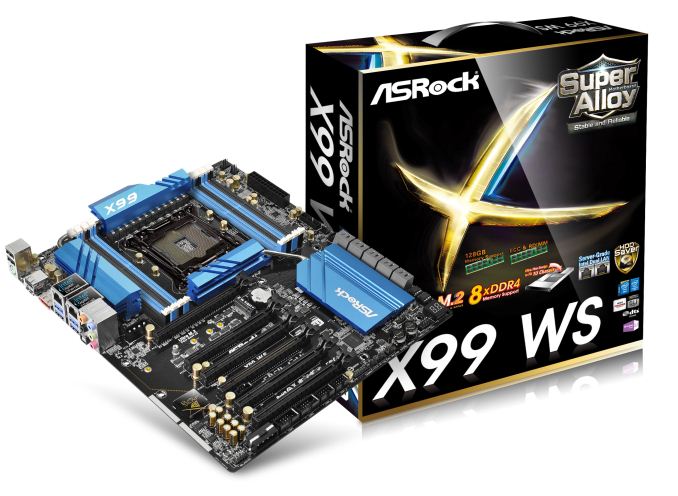The Intel Haswell-E X99 Motherboard Roundup with ASUS, GIGABYTE, ASRock and MSI
by Ian Cutress on September 25, 2014 11:30 AM ESTASRock X99 WS Conclusion
If we were to assign characteristics to a company based on previous launches, ASRock tends to be the one that has a mountain of small new ideas. Some of these ideas work really well and become essential parts of the package, while others initially sound confusing and drop off the radar. While the workstation route is somewhat new to ASRock’s consumer motherboard design team, it seems that the historic characteristics of ASRock are not here in the X99 WS – there is very little that seems ‘new’ compared to everyone else. If we look at other motherboards in this review, we have features such as the OC Socket, the UV light-up rear-panel or interesting PCIe/storage arrangements, but it would seem that ASRock’s effort in the X99 WS is more on the components than the functionality.
The big thing ASRock is promoting with the X99 WS is full Xeon E5 v3 support with ECC and RDIMM verification up to 128GB of memory. The WS is not the only motherboard in the X99 consumer stack to accept Xeons (in fact, most of them will), although few openly announce ECC/RDIMM support. The main lynchpin with ASUS WS motherboards, for example, is QVL support for a large range of additional PCIe devices that regular users do not use (Xeon Phi, RAID cards, FPGA). Unfortunately ASRock has made no effort to communicate that support in their press or online materials, suggesting that the only move towards ‘WS’ naming is the dual Intel NIC design with vPro support (for Windows Server applications) and some higher end components for 12-phase power delivery.
With all this being said, the X99 WS is a more than capable board for a build. It gives a set of six full-length PCIe slots for additional cards, M.2 support up to 110mm and for WS users and a pair of COM headers teamed with a TPM header. We get the enhanced audio with Purity Sound 2 hiding a Realtek ALC1150 codec under an EMI shield, and the extra-large heatsinks should help with heat dissipation. One additional benefit with the WS is that the z-height is sufficient to use this motherboard in a 1U server, allowing for high-density setups. If a user is building a heavy compute platform, there are two additional power connections for PCIe cards, although the 4-pin molex connector in the middle of the board is somewhat unwieldy from a cable management perspective.
From a BIOS and software perspective, the BIOS has been rearranged slightly for manual overclocking which makes it easy to understand where everything is, although there is room for some small adjustment. The aesthetic of the BIOS is very easy to read, which is a bonus, although there is no 'simple mode' similar to the other manufacturers. The software uses the standard A-Tuning interface, and while it offers a good number of options, it does get marked down in a couple of areas where the interface could be improved for a better user experience.
The motherboard offers a number of very positive points in terms of stock performance – the MultiCore Turbo rules giving it a push ahead of the ASUS/GIGABYTE results while having the lowest idle power consumption. The audio is in the middle of the back, while the DPC and POST times are a little behind the best X99 tested in this review. Automatic overclocking offers a good number of options from 4.0 GHz to 4.5 GHz, and manual overclocking reached 4.5 GHz before peak temperatures became too high.
Overall, the ASRock X99 WS performs well out of the box and enforces the support for Xeons + ECC/RDIMMs should a user need it. However, it marks a departure from previous ASRock releases by not adding much ‘extra’ to the overall experience in terms of direct functionality.











62 Comments
View All Comments
nathanddrews - Thursday, September 25, 2014 - link
So which system will serve as the new 2015 gaming review platform? Also, OC + GTX 980 OC Quad-SLI? ;-)techxx - Thursday, September 25, 2014 - link
Why are these things so damn expensive? I was hoping for a Mini-ITX for low $100s.Flunk - Thursday, September 25, 2014 - link
X99 is the workstation/enthusiate platform. You're not likely to see any mini-ITX boards at all, certainly not for $100. Maybe you're thinking of Z97?techxx - Thursday, September 25, 2014 - link
Was right about to correct my post. Yup.Ian Cutress - Thursday, September 25, 2014 - link
We recently reviewed three Z97 mini-ITX at $140 :) http://anandtech.com/show/8276/z97-miniitx-review-...BubbaJoe TBoneMalone - Thursday, September 25, 2014 - link
ASUS Shadowcat x99 mini-itx with usb 3.1 in the works -> http://rog.asus.com/325712014/asus-gaming-motherbo...korben44 - Thursday, September 25, 2014 - link
Sorry, but that Shadowcat is not X99... X99 CPUs do not have onboard graphics chips...editorsorgtfo - Sunday, May 17, 2015 - link
ASRock X99E-ITX/ac but at around 300.just4U - Thursday, September 25, 2014 - link
I'd like to see what they have on the go for MATX.y2kBug - Thursday, September 25, 2014 - link
It's nice to see that these motherboards support Xeon CPUs. Though, does anybody know if Haswell-E Xeons are overclockable? Probably not, but it is nice to know that you can upgrade your machine with 8-Core Xeon in a few years cheaply when big data centers start getting rid of them while upgrading to something new (similar to what is happening to Nehalem/Westmere Xeons now).